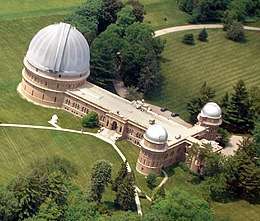Yerkes 41-inch reflector
Yerkes 41-inch reflector is a 40-inch aperture (101.6 cm) reflecting telescope at the Yerkes Observatory, that was completed in 1968. It is known as the 41 inch to avoid confusion with a 40 inch refractor at the observatory. Optically it is a Ritchey–Chrétien design, and the main mirror uses low expansion glass. The telescope was used as a testbed for an adaptive optics system in the 1990s.

History
In the late 1960s a 40-inch reflecting telescope was added, often called the "41 inch" reflector,[1] and in 2002 it was given a new dome over it.[2] The 41 inch was finished by 1968, with overall installation completed by December 1967 and the optics in 1968.[3][4] The telescope had a clear aperture of 40 inches, but was often called the "41 inch" so it would not be confused with the Yerkes 40 inch refractor.[4] Also, the physical diameter of the mirror was 41 inches, even though optical clear aperture was smaller.[3][4]
The 40 inch reflector was of the Ritchey–Chrétien optical design.[5] It systems and the figuring of the glass was mostly completed at the Optical workshop of the Yerkes Observatory.[4] However, the mirror was completed by Tinsley Laboratories, because the person (A graduate student) working on the mirror died unexpectedly.[4] The mirror had a physical diameter of 104 cm and was made from Cer-Vit low-expansion glass.[6] In the 21st century, the 41 inch was placed on the robotic Skynet telescope network, along with a 24-inch telescope at Yerkes.[7]
The telescope is one of three major instruments at the Observatory in the late 20th and 21st century, along with 40-inch refractor and 24-inch reflector; these three telescopes occupy the 3 main telescope domes of the building.[8]
The 41 inch was installed in the southern dome, replacing the old 24-inch (2 foot ) reflecting telescope that dated to the turn of the century.[9] The northern dome housed the new 24 inch, which replaced the Kenwood 12-inch refractor.[9] Both of these domes are on the eastern side of the building along with the meridian transit room.[9] The south-east dome has a diameter of about 30 feet, and was originally designed for 14-inch refractor in the 1890s.[10]
Instruments
The launch instruments for the 41 inch reflector included:[4]
- Image tube spectrograph
- photoelectric photometer
- photoelectric spectrophotometer
The telescope was often used as a testbed for a device known as the Wavefront Control Experiment in the 1990s.[11] This was an adaptive optics system that used a deformable mirror to reduce the blurring caused by disturbances in the atmosphere of Earth.[11] One application was the study of combining adoptive optics with fiber optics for high-accuracy spectrographs.[12] That type of data, given enough accuracy can be used to detect exoplanets by doppler shift.[12]
References
- Roth, Joshua (2004-12-15). "Yerkes On the Block". Sky & Telescope. Retrieved 2019-10-21.
- "Constructive point of view".
- Darling, David. "Yerkes Observatory". www.daviddarling.info. Retrieved 2019-10-24.
- O'Dell, C. R. (1969). "1969BAAS....1..135O Page 135". Bulletin of the American Astronomical Society. 1: 135. Bibcode:1969BAAS....1..135O.
- Krugler, Joel I.; Witt, Adolf N. (1969). "1969PASP...81..254K Page 254". Publications of the Astronomical Society of the Pacific. 81 (480): 254. Bibcode:1969PASP...81..254K. doi:10.1086/128768.
- Monnier, Richard C.; Cooke, Frank (1967). "Fabrication of a 104-cm Mirror from Cer-Vit^R Low Expansion Material". Applied Optics. 6 (8): 1437–40. doi:10.1364/AO.6.001437. PMID 20062231.
- "Skynet: Yerkes-24". skynet.unc.edu. Retrieved 2019-10-28.
- Roth, Joshua (2004-12-15). "Yerkes On the Block". Sky & Telescope. Retrieved 2019-10-28.
- "National Park Service: Astronomy and Astrophysics (Yerkes Observatory)". www.nps.gov. Retrieved 2019-10-28.
- Ritchey, G. W. (1901). "1901ApJ....14..217R Page 217". The Astrophysical Journal. 14: 217. Bibcode:1901ApJ....14..217R. doi:10.1086/140861.
- "Yerkes Observatory: A century of stellar science". chronicle.uchicago.edu. Retrieved 2019-10-28.
- Kibblewhite, Edward J.; Shi, Fang; Wild, Walter J. (1994-05-01). "Coupling efficiency of starlight to low-order-mode optical fibers using adaptive optics: rationale and experiments using the Wavefront Control Experiment". Adaptive Optics in Astronomy. 2201: 949–954. Bibcode:1994SPIE.2201..949K. doi:10.1117/12.176128.